When you’re preparing to pitch an idea or win new work, proposal examples can help you see what makes a document clear, persuasive and effective. By studying real samples, you learn how to define problems, present solutions and outline costs in a way that builds trust with clients or funders. These examples give structure and guidance so you avoid guesswork and focus on what matters most.
This blog shares five proposal examples with analysis, free samples and templates you can adapt to your own projects. Each example highlights best practices you can use right away, whether you are writing a business proposal, a grant request, a work plan, an event proposal or a service offer. With the right format, you can save time, write with confidence and improve your chances of success.
Once proposals are accepted, they shift from persuasive documents to actionable commitments that require careful execution. This is where project management software becomes essential, helping teams move from vision to delivery by organizing tasks, managing resources and tracking timelines. Instead of juggling spreadsheets and emails, managers can centralize work, align stakeholders and keep budgets and schedules under control, ensuring the promises made in the proposal translate into measurable results.
ProjectManager makes this transition seamless by turning accepted proposals into structured plans, with its Gantt chart at the center. The dynamic Gantt chart allows managers to map tasks, set all four types of task dependencies, allocate resources and adjust timelines in real time, so projects stay flexible and on track.
Project managers can filter for the critical path to identify tasks with zero slack and set a baseline to track progress in real time. Combined with additional views, reporting and collaboration features, our software transforms proposals into clear, executable workflows that guide teams from kickoff to successful delivery. Get started with ProjectManager today for free.
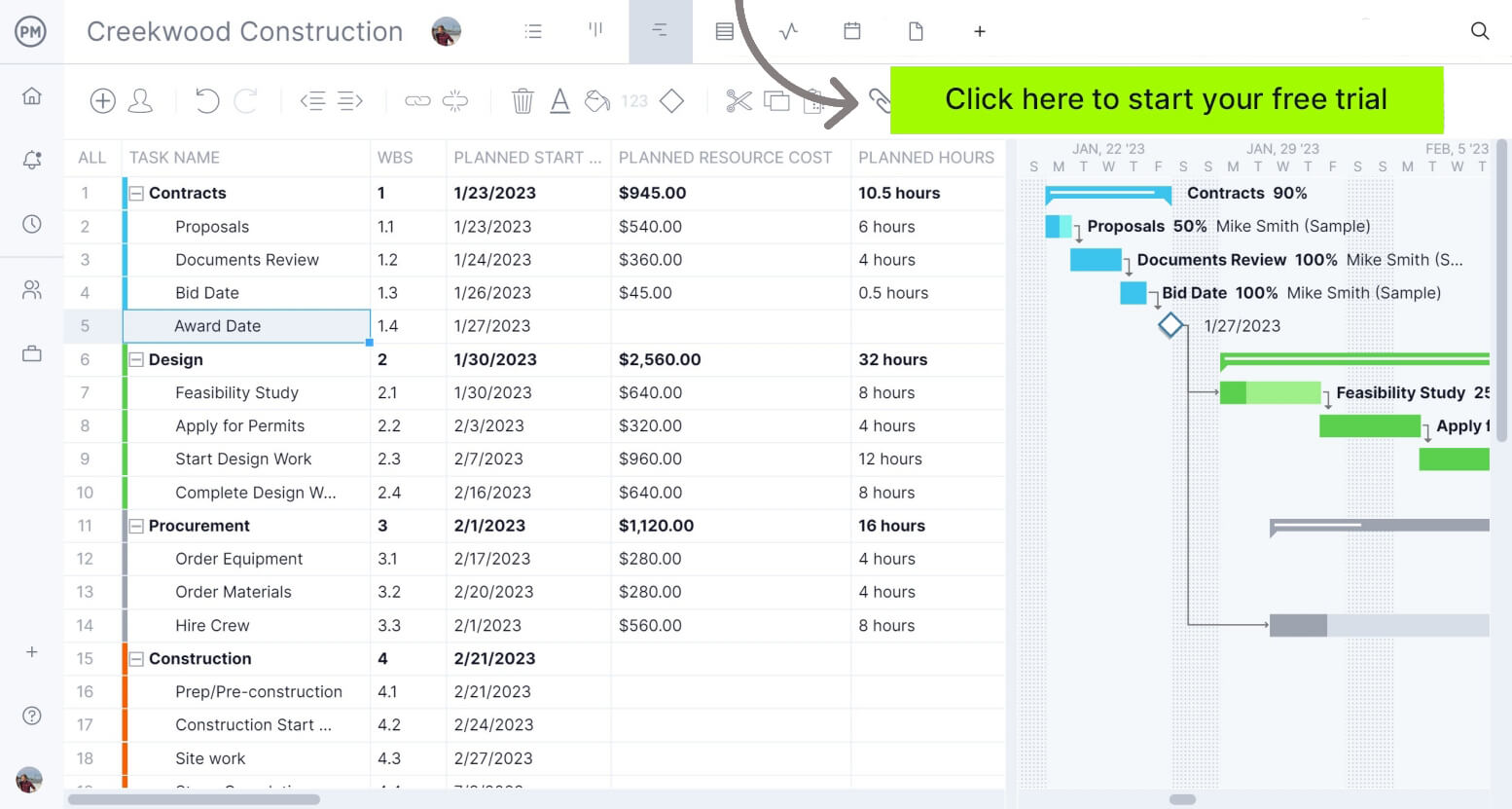
1. Project Proposal Example
The example below illustrates how proposal examples can guide your writing and make complex ideas easier to present. It demonstrates the value of learning from proven formats and highlights why studying real samples is one of the most effective ways to create proposals that are clear, persuasive, and professional.
First, start by downloading the project proposal example as a free template to customize for your own use.
Download This Project Proposal Example
It gives you a ready-made structure so you can focus on content instead of formatting. Here’s a closer look at the components in detail.
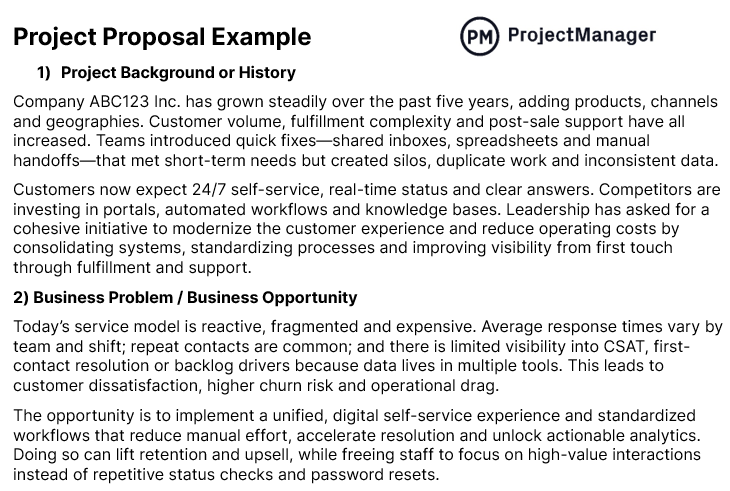
1) Project Background or History
Company ABC123 Inc. has grown steadily over the past five years, adding products, channels and geographies. Customer volume, fulfillment complexity and post-sale support have all increased. Teams introduced quick fixes—shared inboxes, spreadsheets and manual handoffs—that met short-term needs but created silos, duplicate work and inconsistent data.
Customers now expect 24/7 self-service, real-time status and clear answers. Competitors are investing in portals, automated workflows and knowledge bases. Leadership has asked for a cohesive initiative to modernize the customer experience and reduce operating costs by consolidating systems, standardizing processes and improving visibility from first touch through fulfillment and support.
2) Business Problem/Business Opportunity
Today’s service model is reactive, fragmented and expensive. Average response times vary by team and shift; repeat contacts are common; and there’s limited visibility into CSAT, first-contact resolution or backlog drivers because data lives in multiple tools. This leads to customer dissatisfaction, higher churn risk and operational drag.
The opportunity is to implement a unified, digital self-service experience and standardized workflows that reduce manual effort, accelerate resolution and unlock actionable analytics. Doing so can lift retention and upsell, while freeing staff to focus on high-value interactions instead of repetitive status checks and password resets.
3) Proposed Solution
Design and implement a Customer Self-Service Portal and Process Modernization program. The solution includes: a secure portal for order/status lookups, returns, appointments and FAQs; an integrated knowledge base with role-based authoring and feedback loops; workflow automation for common requests; standardized intake via smart forms; and unified reporting across touchpoints.
We will rationalize overlapping tools, migrate essential data, and define end-to-end operating procedures. A pilot will validate usability, KPIs and change readiness, followed by phased rollout. Training, communications and governance will ensure adoption. The architecture will be modular to support future capabilities such as chat, AI-assisted answers and proactive notifications.
4) Project Vision and Goals
Vision: Deliver a modern, self-service experience that customers trust and employees love—simple, fast and transparent.
Goals (12 months post-launch):
- Reduce average response time by 40% and repeat contacts by 30% through self-service and clearer workflows.
- Achieve ≥85% self-service resolution for top 10 request types and raise CSAT by 10 points.
- Consolidate three or more legacy tools into one integrated platform and standardize intake across channels.
- Provide leadership with real-time dashboards on volume, backlog, SLA attainment and root causes to drive continuous improvement and staffing decisions.
- Build a sustainable knowledge management practice with defined ownership, review cadence and contribution incentives.
5) Project Deliverables
- Customer Self-Service Portal: Responsive web interface with authentication, profile management, order/status tracking, returns/RMA initiation, appointment scheduling and request submission.
- Knowledge Base: Taxonomy, style guide, authoring workflow, searchable articles, feedback mechanism and analytics.
- Workflow & Forms: Standardized request types, SLAs, routing rules, escalations and dynamic forms with validation.
- Systems Integration: Connect CRM, order/ERP, ticketing and identity; data migration plan and executed cutover.
- Reporting & Dashboards: KPIs for volume, resolution, SLA, CSAT/NPS and deflection, with drill-downs.
- Change Enablement: Training materials, role-based playbooks, comms plan and support model.
- Governance Pack: RACI, operating procedures, backlog triage and release calendar.
6) Project Timeline (or Timeframe)
Duration: ~24–28 weeks, phased to reduce risk.
- Weeks 1–4 (Discovery & Design): Stakeholder interviews, journey mapping, requirements, solution architecture, initial backlog.
- Weeks 5–8 (Foundation Build): Identity, environments, data model, core integrations, KB framework, UI wireframes.
- Weeks 9–14 (Feature Build): Portal features (status, returns, requests), dynamic forms, routing, dashboards, content creation sprint.
- Weeks 15–18 (Pilot Prep & UAT): Test cases, UAT, accessibility review, training assets, communications.
- Weeks 19–22 (Pilot Launch): Limited audience rollout, KPI tracking, bug fixes, content expansion.
- Weeks 23–26 (Scale Rollout): Phased go-live by region/segment; hypercare and optimization.
- Weeks 27–28 (Transition): Handover to operations, finalize documentation, benefits tracking plan.
7) Resource Requirements
- Project Leadership: 1 Project Manager (0.8–1.0 FTE), 1 Product Owner (0.5–0.8 FTE), Executive Sponsor (as needed).
- Delivery Team: 2–3 Full-stack/Platform Engineers, 1 Integration Engineer, 1 QA Analyst, 1 UX/UI Designer, 1 Content/Knowledge Manager, 1 Data Analyst.
- Business SMEs: 3–5 part-time representatives from Support, Operations, Sales/Account Management and IT Security.
- Change Enablement: 1 Trainer/Change Manager, 1 Communications Specialist (shared).
- Vendors/Tools: Portal platform licenses, analytics/BI, knowledge software (if not native), test tools.
- Facilities & Misc.: Sandbox and test environments, accessibility and security review time, end-user pilot participants.
8) Estimated Project Budget
One-Time (CapEx/Project):
- Platform configuration & integrations: $180,000–$260,000
- UX, content development and knowledge base setup: $60,000–$90,000
- Data migration and QA/testing: $40,000–$70,000
- Change management, training and launch communications: $35,000–$55,000
- Subtotal One-Time: $315,000–$475,000
Ongoing (Annual OpEx):
- Licenses/hosting: $90,000–$140,000
- Support/enhancements & content maintenance: $80,000–$120,000
- Analytics/monitoring and minor releases: $30,000–$50,000
- Subtotal Ongoing: $200,000–$310,000 per year
Assumptions: moderate complexity integrations, phased rollout, and partial internal staffing.
9) Potential Project Risks
- Adoption Risk: Low portal/KB usage if content is thin or navigation is confusing. Mitigation: user testing, clear IA, content quality gates and targeted training.
- Integration Complexity: Legacy systems may have inconsistent APIs or data quality issues. Mitigation: early technical spikes, data profiling and incremental sync patterns.
- Scope Creep: Stakeholders may push for edge cases in phase one. Mitigation: strict MVP criteria, change control board and backlog governance.
- Security & Compliance: PII exposure or access misconfiguration. Mitigation: security reviews, least-privilege roles, audit logs and penetration testing.
- Operational Load: Support team stretched during transition. Mitigation: hypercare staffing, clear escalation paths and temporary surge capacity.
10) Project Success Criteria
- Customer Outcomes: ≥85% self-service resolution for the top 10 request types; +10-point CSAT improvement; 20% reduction in churn among serviced cohorts.
- Operational Outcomes: 40% faster average response time; 30% fewer repeat contacts within 7 days; ≥95% SLA attainment for standard requests.
- Business Outcomes: 15–25% reduction in cost-to-serve for eligible interactions; measurable uplift in cross-sell/upsell from contextual recommendations.
- Process & Quality: Knowledge articles meet style/accuracy standards with quarterly review ≥95% on time; audit logs show compliant access; backlog aging reduced by 25%.
- Sustainability: Governance operating, dashboards adopted by leadership and two continuous-improvement releases delivered within 90 days post-launch.
Project Proposal Template
Download this free project proposal template, which provides a structured format to outline goals, scope, timeline and costs for any project.
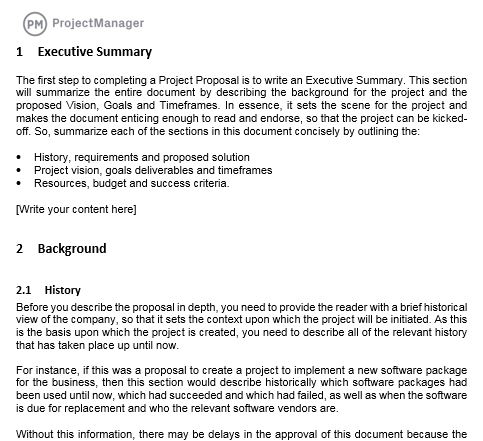
It saves time, ensures consistency, and helps present ideas clearly and professionally.
2. Work Proposal Example
This example shows how a project proposal can present a complex residential build in a clear and professional format. It breaks down the work into sections such as project summary, scope of work, timeline, cost estimate, and terms, so the client understands exactly what is included. The proposal builds trust, sets expectations, and helps both parties align on budget and delivery before work begins.
You can download this work proposal example as a free template to adapt for your own projects.
Download This Work Proposal Example
This structure allows you to focus on details that win client approval.

1) Project Summary
This proposal covers the design and construction of a custom in-ground residential pool with an adjacent tiki bar/entertaining area. The pool is envisioned as ~15′ × 30′ gunite (3.5′ shallow to 6′ deep) with a 7′ × 10′ tanning shelf, LED lighting, energy-efficient variable-speed pump, cartridge filtration, salt-chlorination, and optional heat pump. Finishes include waterline tile, travertine coping, and ~600 sq ft of non-slip paver decking.
The tiki bar (~12′ × 16′) will feature a concrete slab, timber posts, thatch-style or metal roof (owner’s choice), stone or composite cladding, quartz/granite countertop, undermount sink, under-counter refrigerator, dedicated GFCI circuits, ceiling fan/light kit, and gas stub for a built-in grill. Scope includes permits, inspections, drainage improvements, equipment pad, subpanel, bonding/grounding, startup, and homeowner orientation.
2) Scope of Work
- Design & Permitting: Site survey review, utility locates, engineered pool plans, drainage plan, HOA/municipal permits, inspection scheduling.
- Site Prep & Excavation: Layout, erosion controls, access protection, excavation, export of spoils as needed.
- Pool Structure: Steel rebar cage, plumbing stub-outs, gunite/shotcrete shell, equipment pad, bonding grid.
- Mechanical/Plumbing: Main drains (VGB compliant), skimmers, returns, vacuum line, auto-fill, overflow, heater/heat pump (optional), salt cell, valves, pressure test, equipment start-up.
- Electrical: 240V subpanel, conduit, bonding/grounding, LED nicheless lights, GFCIs, equipment interconnects, code-required alarms as applicable.
- Finishes & Decking: Waterline tile, travertine coping, interior finish (mini-pebble or quartz), ~600 sq ft paver deck, control joints, deck drains.
- Tiki Bar: Slab-on-grade, posts/beam framing, thatch-style or metal roof, weather-resistant finishes, countertop, sink + cold water supply + drain to code, under-counter fridge, fan/light, task lighting, outlets, gas stub for grill.
- Sitework: Positive drainage away from structures, final grading, haul-off, rough landscaping repair at work limits.
- Owner Training & Turnover: Water chemistry primer, equipment operations, O&M manuals, warranty package.
- Allowances (owner to select): Waterline tile, interior finish, coping stone, paver style, countertop material, bar façade, appliance package, roof finish.
- Exclusions (unless listed): New perimeter fencing, landscaping/irrigation beyond repair, utility upgrades off-property, septic relocation, unforeseen rock removal, soil remediation, specialty audio/TV, and permitting/impact fees beyond standard pool/tiki scope.
3) Project Timeline
Total duration is estimated at 10–14 weeks after permit issuance and final selections (weather and inspection schedules may affect dates).
- Weeks 1–2: Design & Permits — Finalize selections, engineering, HOA/city submittals, utility locates.
- Weeks 3–4: Layout & Excavation — Access prep, dig, steel, rough plumbing, inspection.
- Weeks 5–6: Shell — Gunite/shotcrete placement, initial cure, equipment pad build, set tile/coping.
- Weeks 7–8: Tiki Bar Structure — Slab, posts/beams, roof system, rough electrical/plumbing.
- Weeks 9–10: Decking & Finishes — Pavers, deck drains, interior pool finish application.
- Week 11: Mechanical/Electrical Finish — Set equipment, pull wire, terminations, inspections.
- Week 12: Start-Up — Fill, startup chemistry, equipment balancing, training, punch-list.
- Weeks 13–14: Closeout — Final inspections, CO (if required), warranty/turnover.
4) Cost Estimate
All amounts are in USD; final pricing depends on selections, access, soil conditions and engineering.
| Line Item | Estimated Range |
|---|---|
| Design, Engineering, Permits & Inspections | $4,500 – $7,500 |
| Site Prep, Access Protection & Excavation | $8,000 – $14,000 |
| Steel, Plumbing Rough-In & Gunite/Shotcrete Shell | $38,000 – $52,000 |
| Filtration, Pump, Salt System, Valves & Heater/Heat Pump (opt.) | $12,000 – $18,000 |
| Electrical (subpanel, lights, bonding, outlets, code alarms) | $6,500 – $9,500 |
| Waterline Tile & Travertine Coping | $6,000 – $9,000 |
| Interior Finish (mini-pebble or quartz) | $5,000 – $8,000 |
| Paver Deck (~600 sq ft incl. base & drains) | $12,000 – $18,000 |
| Tiki Bar Structure (slab, framing, roof) | $18,000 – $28,000 |
| Tiki Finishes & Appliances (counter, façade, sink, fridge, fan) | $8,000 – $14,000 |
| Gas/Water/Drain Extensions to Bar/Grill | $4,000 – $7,000 |
| Drainage/Grading & Site Restoration | $3,000 – $5,000 |
| Startup, Training & Closeout | $1,000 – $1,500 |
| Contingency (10%) | $12,000 – $19,000 |
| Estimated Total | $138,000 – $209,000 |
Notes: Appliance/grill packages vary widely; premium materials (stone façades, quartzite, designer tile) may increase costs. Rock, expansive clay, dewatering, or utility conflicts may require change orders.
5) Terms and Conditions
- Payment Schedule: 10% deposit at contract; 30% after excavation/steel; 30% after gunite; 20% after decking/tiki dry-in; 10% at substantial completion (before final).
- Change Orders: Scope changes or unforeseen conditions (rock, unsuitable soils, unknown utilities) require signed change orders with cost/time impacts.
- Warranties: Structure (pool shell) 10 years; equipment per manufacturer (typically 3 years when installed as a system); workmanship 1 year.
- Permits & Compliance: Contractor obtains permits and schedules inspections; work adheres to applicable building, electrical, gas, and pool safety codes (including bonding, GFCI, VGB compliance, barriers/alarms where required).
- Site Access & Protection: Owner to provide clear access; contractor protects driveways and adjacent improvements within reasonable means; dust/noise controlled per ordinance; typical work hours Mon–Sat, 8am–6pm.
- Utilities & Locates: Public locations requested before excavation; owner to identify private lines (irrigation, low-voltage, septic). Repairs to unidentified/unmarked private lines are billable.
- Materials & Substitutions: If specified items face supply issues, the contractor may propose equals for owner approval without cost premium where feasible.
- Insurance & Safety: Contractor maintains general liability, workers’ comp, and auto insurance; jobsite kept orderly; trench and fall hazards mitigated; fenced or otherwise secured when unattended.
- Retention & Lien Releases: Progress payments subject to lien releases; 5% retention may be withheld until completion.
- Validity: Pricing valid 30 days; start date contingent on permit issuance, selections, and deposit.
Work Proposal Template
Download a work proposal template to save time and keep your proposals consistent.
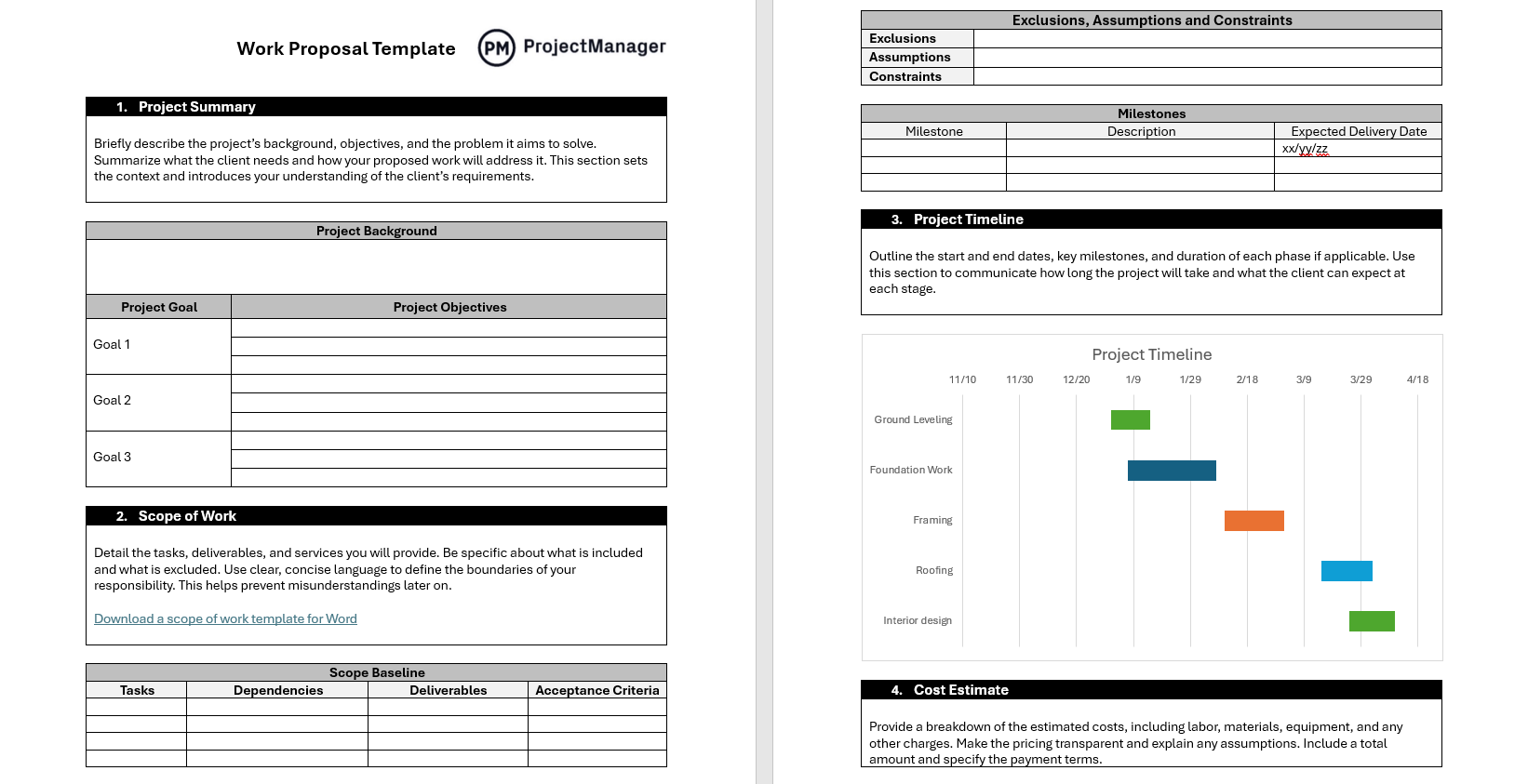
It provides a clear structure so you can present scope, timeline and costs with confidence.
3. Business Proposal Example
This example demonstrates how a business proposal can address complex challenges with a structured, professional approach. It moves from identifying the problem and analyzing needs to presenting a solution, scope, timeline, costs, company credentials and terms. By organizing the content this way, the proposal builds credibility, sets clear expectations, and gives decision makers the confidence to move forward.
You can quickly download this business proposal example by clicking the image below.
Download This Business Proposal Example
The business proposal example file is ready to use and fully editable for your projects.
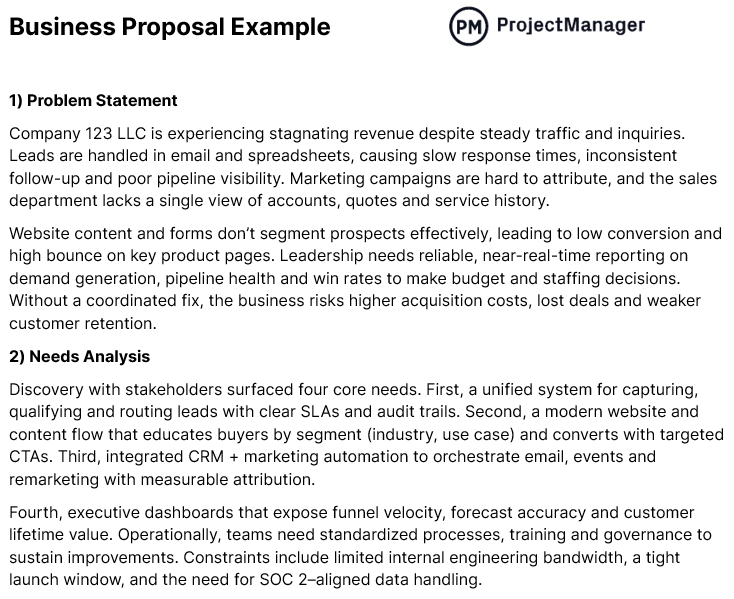
1) Problem Statement
Company 123 LLC is experiencing stagnating revenue despite steady traffic and inquiries. Leads are handled in email and spreadsheets, causing slow response times, inconsistent follow-up and poor pipeline visibility. Marketing campaigns are hard to attribute, and the sales department lacks a single view of accounts, quotes and service history. Website content and forms don’t segment prospects effectively, leading to low conversion and high bounce on key product pages. Leadership needs reliable, near-real-time reporting on demand generation, pipeline health and win rates to make budget and staffing decisions. Without a coordinated fix, the business risks higher acquisition costs, lost deals and weaker customer retention.
2) Needs Analysis
Discovery with stakeholders surfaced four core needs. First, a unified system for capturing, qualifying and routing leads with clear SLAs and audit trails. Second, a modern website and content flow that educates buyers by segment (industry, use case) and converts with targeted CTAs. Third, integrated CRM + marketing automation to orchestrate email, events and remarketing with measurable attribution.
Fourth, executive dashboards that expose funnel velocity, forecast accuracy and customer lifetime value. Operationally, teams need standardized processes, training and governance to sustain improvements. Constraints include limited internal engineering bandwidth, a tight launch window, and the need for SOC 2–aligned data handling.
3) Proposed Solution
We propose a phased “Lead-to-Revenue Modernization” program:
- Redesign the website’s key funnels with role-based content, high-intent forms and calendar booking.
- Implement an integrated CRM (Sales + Service) and marketing automation platform, including lead scoring, nurture journeys and sales playbooks.
- Build data integrations for products/orders, email and web analytics, enabling first-touch to closed-won attribution.
- Stand up executive dashboards (pipeline, forecast, ACV, CAC/LTV) with drill-downs, and train teams on new workflows and governance. The architecture will be modular, secure and scalable, with strict role-based access and audit logging. A pilot will validate usability, KPIs and change readiness before full rollout.
4) Project Scope
In Scope: UX research, information architecture, copy and page templates for priority journeys; CRM setup (objects, fields, roles, pipelines), case management, knowledge base starter; marketing automation (forms, scoring, nurtures), basic consent management; data integrations for website, email and order system; analytics dashboarding; documentation, training and change enablement; hypercare post-launch.
Out of Scope (Phase 1): Custom mobile app, advanced CPQ, full customer data platform, complex territory modeling, data lake build-out, bespoke ERP customization.
Deliverables: Wireframes, component library, CRM config pack, integration specs, test cases, training materials, runbooks, and governance (RACI, intake, release calendar).
5) Project Timeline
Duration: ~16 weeks, phased to de-risk delivery.
- Weeks 1–3 | Discovery & Design: Stakeholder workshops, analytics review, UX research, requirements, solution architecture, backlog and success metrics.
- Weeks 4–7 | Build Foundations: Website templates/components, CRM data model and pipelines, permissioning, core integrations, initial automations.
- Weeks 8–11 | Feature Build & Content: High-intent pages and forms, nurture journeys, sales playbooks, dashboards; QA and data validation.
- Weeks 12–13 | UAT & Pilot: User training, pilot cohort launch, KPI tracking, bug fixes.
- Weeks 14–16 | Go-Live & Hypercare: Phased rollout, knowledge transfer, stabilization, post-launch optimization and benefits tracking plan.
6) Estimated Cost Breakdown
All figures in USD; travel, taxes and software licenses excluded unless noted.
One-Time (Project)
| Category | Cost |
|---|---|
| Discovery & UX/Content Design | $28,000 |
| CRM & Marketing Automation Implementation | $72,000 |
| Data Integration & Migration | $22,000 |
| QA, Security Review & UAT | $14,000 |
| Training, Change & Documentation | $16,000 |
| Project Management & Governance | $20,000 |
| Total One-Time | $172,000 |
Recurring (Monthly)
| Category | Cost/Month |
|---|---|
| Software Licenses (CRM + MA) | $3,000 |
| Hosting/Analytics | $1,000 |
| Support & Enhancements Retainer | $6,000 |
| Total Monthly | $10,000 |
Optional Add-Ons: Advanced CPQ ($35,000), CDP pilot ($40,000 + $2,000/mo), Paid media management ($8,000/mo).
Assumptions: Moderate integration complexity, client provides subject-matter experts, and content production beyond templates is limited to five priority pages.
7) Company Overview
[Your Company] is a strategy and implementation partner specializing in revenue operations, CRM and digital experience for B2B brands. Over 10+ years, we’ve delivered more than 150 transformations across manufacturing, SaaS and professional services, combining product thinking with disciplined project management.
Our team blends certified CRM architects, full-stack engineers, UX writers and change managers. We operate with a playbook that emphasizes measurable outcomes, security by design and knowledge transfer so clients stay self-sufficient. We maintain partnerships with leading platforms (CRM, marketing automation, analytics) and uphold rigorous delivery standards, including code reviews, accessibility checks and stakeholder training.
8) Terms and Conditions
- Payment & Invoicing: 40% at kickoff, 30% at design sign-off, 30% at launch; Net 15.
- Change Control: Any scope variance requires a written change order with timeline/cost impact.
- Intellectual Property: Client owns deliverables upon full payment; vendor retains pre-existing tools and accelerators.
- Confidentiality & Data Protection: Mutual NDA; vendor follows least-privilege access, audit logging and secure storage; SOC 2–aligned practices.
- Warranties & Support: 30-day defect warranty for implementation; optional support retainer covers break/fix and minor enhancements.
- Liability: Capped at 12 months of fees; no indirect or consequential damages.
- Termination: Either party may terminate for material breach with 15 days to cure.
- Governing Law: [State/Country]; venue in [County].
Acceptance: Deliverables accepted upon the criteria in the agreed test plan.
Business Proposal Template
You can download this free business proposal template instantly with a single click.
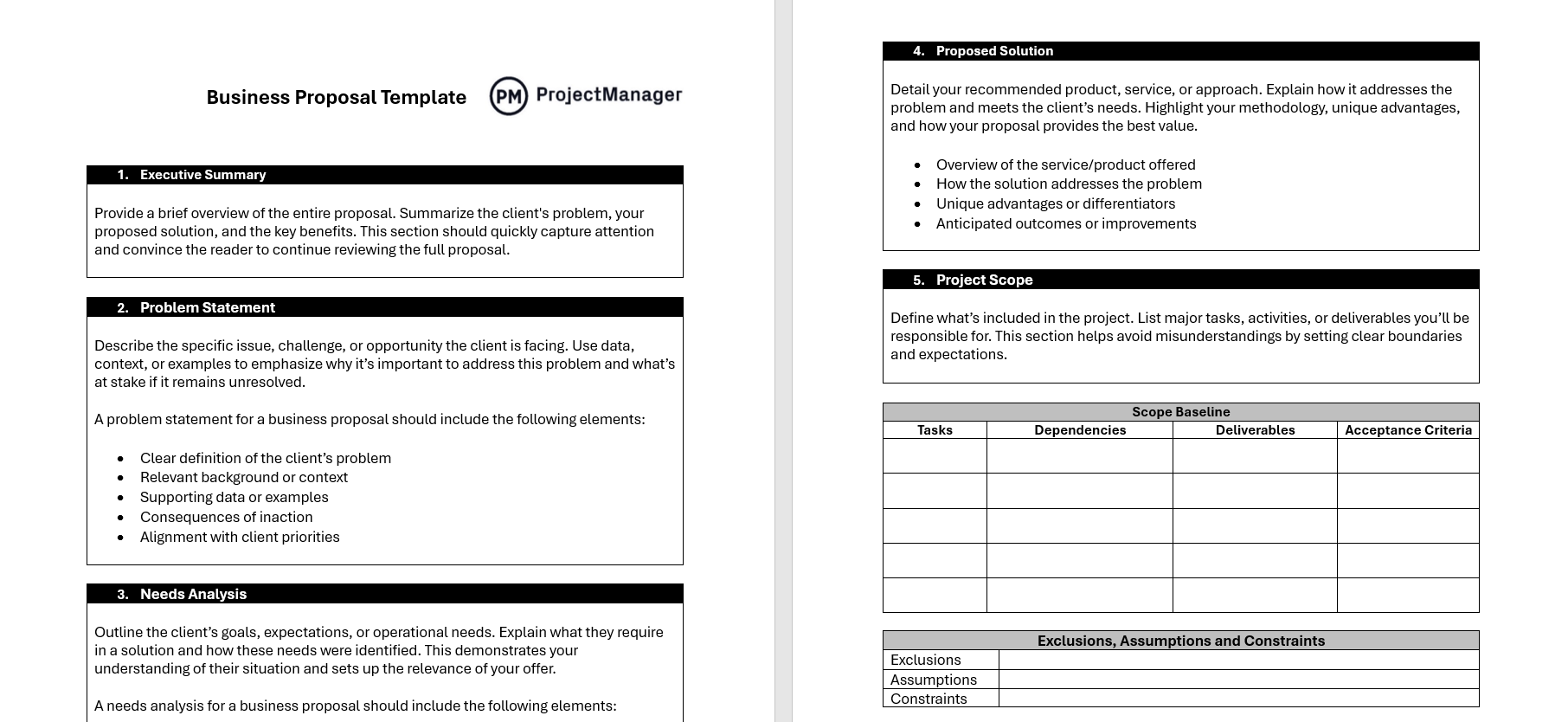
It comes ready to customize for your specific project needs.
4. Event Proposal Example
This event proposal example outlines a one-night, outdoor ticketed concert featuring emerging regional artists and a nationally recognized headliner. It provides a complete guide for organizers, sponsors and stakeholders, covering objectives, target audiences, schedules, marketing strategies, budgets and key performance indicators. This proposal example shows how to plan an engaging, safe and inclusive event that balances entertainment with operational efficiency, community involvement and financial goals.
You can download this free event proposal example below instantly with a single click.
Download This Event Proposal Example
It’s fully editable and ready to use for your own event planning.
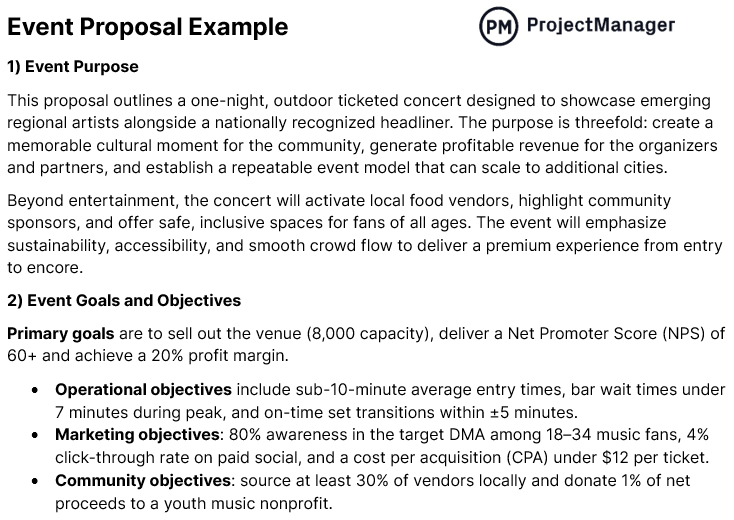
1) Event Purpose
This proposal outlines a one-night, outdoor ticketed concert designed to showcase emerging regional artists alongside a nationally recognized headliner. The purpose is threefold: create a memorable cultural moment for the community, generate profitable revenue for the organizers and partners and establish a repeatable event model that can scale to additional cities. Beyond entertainment, the concert will activate local food vendors, highlight community sponsors and offer safe, inclusive spaces for fans of all ages. The event will emphasize sustainability, accessibility and smooth crowd flow to deliver a premium experience from entry to encore.
2) Event Goals and Objectives
- Primary goals are to sell out the venue (8,000 capacity), deliver a Net Promoter Score (NPS) of 60+ and achieve a 20% profit margin.
- Operational objectives include sub-10-minute average entry times, bar wait times under 7 minutes during peak and on-time set transitions within ±5 minutes.
- Marketing objectives: 80% awareness in the target DMA among 18–34 music fans, 4% click-through rate on paid social and a cost per acquisition (CPA) under $12 per ticket.
- Community objectives: source at least 30% of vendors locally and donate 1% of net proceeds to a youth music nonprofit.
3) Target Audience
The core audience is 18–34-year-old pop/indie and alt-R&B listeners within a 150-mile radius, digitally savvy and highly active on Instagram and TikTok. Secondary segments include families with teens (for early performances) and 25–44 “experience seekers” who prioritize premium amenities such as VIP lounges and expedited entry. Psychographics center on discovery (seeking new artists), social sharing (UGC creators) and values-driven purchasing (sustainability and community). Accessibility is essential: clear mobility routes, visual/auditory accommodations and Spanish-language signage support a broader, more inclusive audience.
4) Event Stakeholders
Key stakeholders include the Organizer/Promoter (overall P&L, booking, operations), Artist Management (performance terms, hospitality, meet-and-greet logistics), Venue Owner/City (permits, noise curfews, public safety) and Production Vendors (staging, sound, lighting, video). Sponsors (beverage, telecom, auto) receive on-site branding, digital placements and hospitality. Food & Beverage Partners manage concessions under agreed revenue shares. Public Safety involves private security, EMTs and coordination with local police and fire. Ticketing Partner handles sales, scanning, fraud prevention and data feeds. Community Organizations collaborate on volunteers, sustainability initiatives and post-event impact reporting.
5) Event Schedule
Timeline (high level):
- T-12 to T-8 weeks: Booking confirmed, contracts executed, creative assets produced, initial sponsor lock-ins, permit applications submitted.
- T-8 to T-4 weeks: Full marketing launch, vendor onboarding, staffing plan, production design freeze, safety plan review.
- T-4 to T-1 week: Final site walk, load-in schedule, credentialing, volunteer training, contingency drills, ticketing QA.
- Event Day:
- 10:00–14:00 Load-in & sound checks
- 16:00 Gates open, DJs & activations
- 18:00 Opener 1, 18:45 Opener 2, 19:30 Special guest
- 20:30 Headliner (90 minutes)
- 22:15 Encore / 22:30 Curfew
- 22:30–02:00 Load-out & sweep
- T+1 week: Debrief, KPI review, settlements, post-mortem report, content recap to sponsors.
6) Event Marketing and Promotion Activities
- Awareness: teaser video, artist co-posts, local radio drops, PR to culture/entertainment outlets and OOH near campuses/venues.
- Consideration: artist interview clips, behind-the-scenes rehearsal footage and playlist partnerships on Spotify/Apple Music.
- Conversion: timed price tiers, limited VIP drops and retargeting audiences built from video views and email opens.
- Community & UGC: TikTok dance prompt using the headliner’s single, fan art contest and geo-fenced AR filter at the venue.
- CRM: staggered email/SMS with urgency copy, weather updates, parking tips and post-purchase share assets to drive referrals.
7) Estimated Event Cost
Major budget categories (indicative, for 8,000 capacity):
- Artist fees & hospitality: $320,000–$420,000 (headliner + support, riders)
- Production (stage, audio, lighting, video, backline): $180,000–$240,000
- Venue, permits, insurance, compliance: $80,000–$120,000
- Staffing (security, EMTs, FOH/BOH, cleaning): $90,000–$130,000
- Marketing & creative (paid media, PR, content): $120,000–$170,000
- Ticketing & merchant fees: $70,000–$95,000
- Ops & logistics (fencing, power, restrooms, radios): $60,000–$90,000
- Contingency (10% of above): $92,000–$126,500
Total Estimated Cost: $1.01M–$1.39M. Revenue streams include tickets (GA/VIP), sponsorships, concessions share, parking, and merch percentage (per artist terms).
8) Event Key Performance Indicators (KPIs)
- Sales & Revenue: tickets sold vs capacity, revenue per attendee (RPA), VIP uptake, sponsor ROI (impressions, engagements, on-site leads).
- Operations: average gate throughput, bar queue wait times, medical incidents per 1,000 attendees, on-time performance.
- Experience: NPS, post-event survey CSAT on sound quality, sightlines, cleanliness and safety; social sentiment and UGC volume.
- Marketing: reach, CPM, CTR, CPA, video completion rate, cost per engaged view, email open/click rates.
- Sustainability: diversion rate for recyclables/compost, generator fuel usage and local vendor participation. Success is defined as sellout, NPS ≥60, 20% margin and sponsor renewal interest ≥75%.
Event Proposal Template
Download this free proposal template quickly and easily with one click.
 It’s fully customizable to fit any project or business need.
It’s fully customizable to fit any project or business need.
5. Grant Proposal Example
This project proposal example outlines a plan to establish a low-impact, U.S.-based lithium extraction and processing facility that addresses the country’s growing strategic demand for domestically sourced battery materials. It details the statement of need, project purpose, scope, budget, timeline, evaluation, sustainability and organizational structure, providing a roadmap for achieving operational, environmental and community objectives.
The proposal example demonstrates how federal support can de-risk first-of-a-kind projects, attract private investment and create high-quality local jobs while ensuring measurable reductions in water and energy use and promoting transparent environmental stewardship.
You can download this grant proposal example instantly with a single click.
Download This Grant Proposal Example
This document is fully editable and ready to use for your own project submissions.

1) Statement of Need
The United States faces a strategic shortfall in domestically sourced lithium, a critical material for grid-scale storage and electric vehicles. Demand is accelerating while the majority of refined supply is imported, creating price volatility, geopolitical exposure and long lead times for energy projects. In parallel, disadvantaged communities near legacy extraction sites have experienced limited economic benefits and disproportionate environmental burdens.
This project addresses both challenges by building a low-impact lithium extraction and processing facility that prioritizes water stewardship, air quality and local hiring. DOE support is needed to de-risk first-commercial deployment and catalyze private capital for a resilient, U.S.-based battery materials supply chain.
2) Project Purpose, Goals and Objectives
- Purpose: Construct and commission an integrated lithium facility that can reliably deliver battery-grade lithium hydroxide to U.S. cathode and cell manufacturers.
- Goals: Produce up to 20,000 metric tons per year of battery-grade product; achieve measurable reductions in water and energy intensity versus conventional methods; create high-quality jobs with training pathways for local residents; demonstrate transparent environmental performance that meets or exceeds federal and state standards.
- Objectives: Complete permitting and design within 12 months; commission core process units by Month 28; reach 70% nameplate within 9 months of start-up; maintain ≥99.5% product purity; publish quarterly community and ESG metrics aligned to DOE guidance and Justice40 objectives.
3) Project Scope
The project encompasses site preparation, civil works and construction of a modular extraction and processing plant, including feed pre-treatment, selective lithium recovery units, purification, crystallization to lithium hydroxide monohydrate and packaging. Supporting systems include water recycling, brine/solution handling, reagent storage under secondary containment, combined heat and power (or interconnection to low-carbon power) and a plantwide distributed control system.
Non-process scope covers laboratory and QA/QC facilities, maintenance shop, warehousing and administrative space. The project also funds workforce development, community benefits (e.g., internships, contractor up-skilling, local supplier development) and comprehensive monitoring for water use, emissions and noise. Deliverables include stamped engineering packages, operating procedures, HAZOP/LOPA studies, emergency response plans and full commissioning documentation.
4) Budget Justification
Federal support is catalytic for first-of-a-kind, domestically sited battery-material projects where technology, integration and commodity risks constrain private financing. DOE funding will primarily offset high-capex items—process equipment, utilities integration, and grid upgrades—while the applicant provides the required non-federal cost share (≥50%) across engineering, construction management, owner’s team, and working capital for commissioning.
The grant accelerates deployment of lower-impact extraction and closed-loop water management, reducing lifecycle emissions and water intensity. It also enables robust community benefits—apprenticeships, local procurement targets, and environmental monitoring—that would otherwise be scaled back. Every federal dollar unlocks multiple private dollars, shortens time-to-market for U.S. battery supply chains, and advances Justice40 by channeling tangible economic opportunity to nearby communities.
5) Project Budget
All figures USD; rounded; subject to detailed EPC estimates and vendor quotes.
Capital Expenditures (CAPEX)
- Sitework, civil, foundations: $42,000,000
- Process equipment (extraction, purification, crystallization): $165,000,000
- Utilities & balance of plant (water recycling, power, steam, air): $58,000,000
- Electrical, controls, and instrumentation (DCS/MES, metering): $34,000,000
- Buildings (admin, lab, warehouse, maintenance): $21,000,000
- Engineering, procurement & construction management (EPCM): $46,000,000
- Permitting, EHS, compliance & monitoring systems: $9,000,000
- Workforce & community benefits (training, apprenticeships, CBAs): $7,000,000
- Start-up, commissioning & spares: $12,000,000
- Contingency (≈12% blended): $47,000,000
Total CAPEX: $441,000,000
Funding Plan (illustrative): DOE Grant $200,000,000; Applicant/Private Cost Share $241,000,000. (Operating costs and working capital during ramp-up are covered by applicant financing.)
6) Project Timeline
- Months 0–6 (Pre-construction): Finalize MOUs with offtakers; complete geotech, environmental baseline studies and conceptual engineering; submit permit applications; initiate NEPA review and community engagement sessions.
- Months 7–12 (FEED & Procurement): Complete front-end engineering design (FEED), HAZOP, long-lead equipment POs and interconnection agreements; publish Community Benefits Plan milestones.
- Months 13–24 (Construction Phase I): Civil works, foundations, undergrounds, structural steel; install utilities and primary process skids; recruit and train first operator cohort.
- Months 25–30 (Construction Phase II): Mechanical, electrical and instrumentation completion; control system integration; water-recycle and waste systems commissioning.
- Months 31–36 (Commissioning & Ramp-Up): Cold/hot commissioning, performance testing, first product shipment by Month 33, ramp to 70% nameplate by Month 36; compile performance, environmental and community reports to DOE.
7) Evaluation Plan
The project will use a mixed-methods evaluation aligned with DOE reporting protocols. Operational KPIs include product purity, recovery rate, throughput, specific energy use (kWh/kg product), and specific water consumption (m³/ton product). Environmental KPIs track Scope 1 and 2 emissions, water recycling percentage, effluent quality versus permits, and waste disposition. Workforce & Community KPIs measure local hire %, apprenticeship completions, supplier diversity spend, and incident rates. Data is captured via the plant DCS/MES and environmental monitoring network, with third-party verification each quarter. A logic model links inputs (capital, training) to outputs (tons, jobs) and outcomes (domestic supply resilience). A learning agenda codifies testable questions, and quarterly after-action reviews drive corrective actions.
8) Sustainability Plan
Post-grant, the facility is financially sustained by multi-year offtake agreements with U.S. cathode and cell manufacturers and optional tolling arrangements. Continuous improvement reduces unit costs through heat integration, reagent optimization and predictive maintenance. Environmental sustainability is anchored by closed-loop water systems, leak detection and repair (LDAR), and a progressive reclamation plan with bonding for end-of-life closure. The project commits to annual public ESG disclosures, community advisory board meetings and third-party audits. A portion of operating cash flow funds R&D for process intensification and eventual capacity expansion. By Year 3 of operation, the plant targets positive free cash flow at ≥80% utilization without additional federal support.
9) Organizational Information
Applicant: [Company/Consortium Name], a U.S.-based critical-minerals developer with expertise in process engineering, project finance, and responsible operations. The leadership team includes a Project Executive (EPC/EPCM background), Director of EHS & Compliance (mining/chemical manufacturing), Plant Manager (operations and reliability), and Community Benefits Lead (workforce development partnerships). Key Partners: Experienced EPC contractor; university research center for continuous process optimization; workforce boards and community colleges for training pipelines; and independent environmental consultants for monitoring and reporting. Governance includes a steering committee with DOE observer participation, internal controls aligned to federal grant requirements, and audited financials. The organization has successfully delivered prior industrial projects safely, on budget, and in compliance with federal and state regulations.
Grant Proposal Template
Download this free grant proposal template quickly with one click.
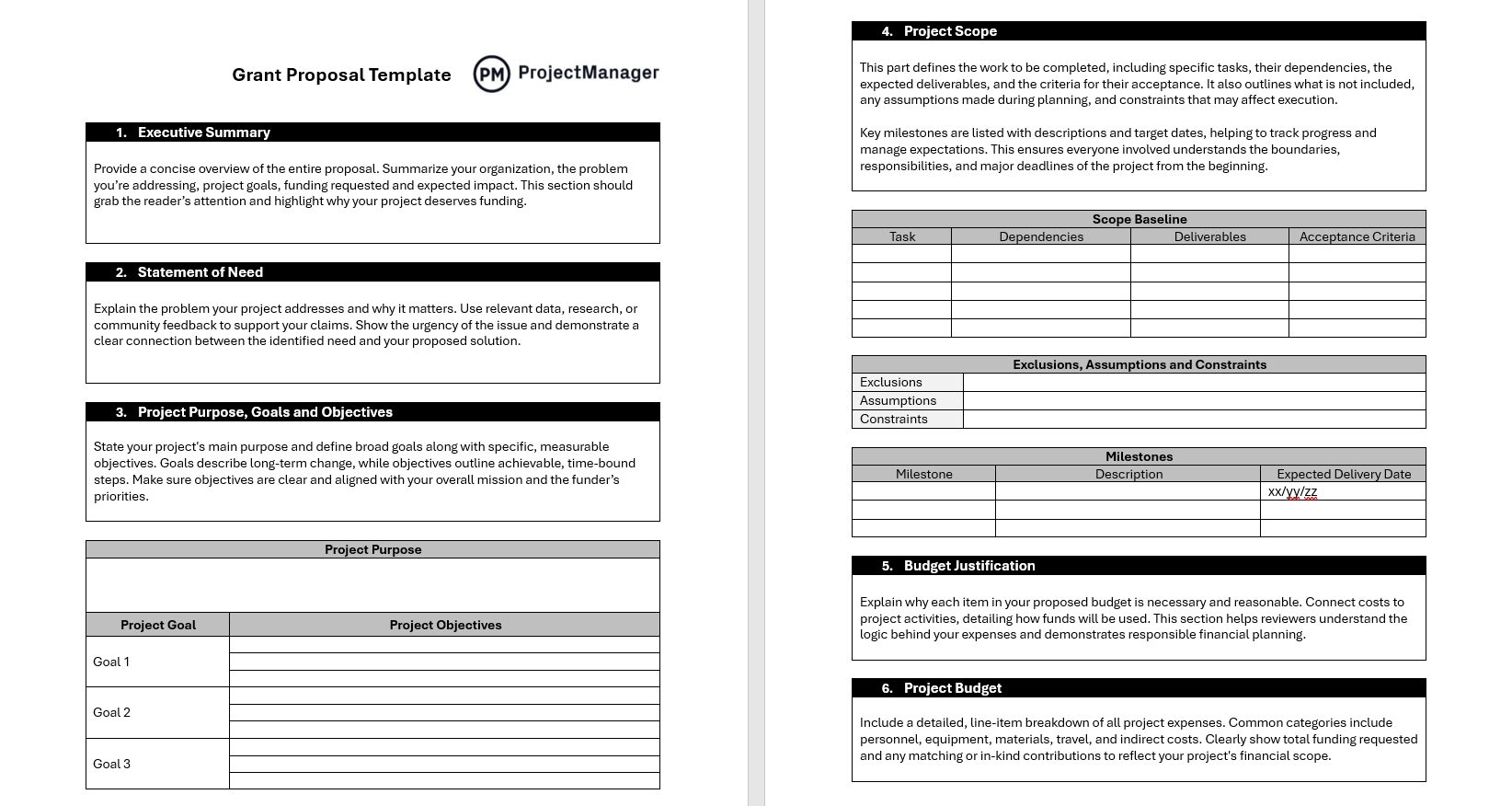
It’s fully customizable for your project or funding application needs.
How ProjectManager Helps Manage Projects
Once a proposal is accepted, ProjectManager streamlines resource management by giving managers complete visibility over team availability, skill sets and workloads. Assignments can be balanced in real time to prevent bottlenecks and over-allocation, ensuring every task has the right person at the right time.
Built-in tools track capacity, holidays and absences, while automated alerts notify managers of potential conflicts, helping projects stay on schedule and on budget. This centralized approach also simplifies vendor or contractor management, keeping internal and external resources aligned with project priorities.
Leverage Multiple Project Views
We also have multiple project views beyond the Gantt chart to accommodate different team and stakeholder needs. Kanban boards help visualize workflow and track task progress, while task lists give a straightforward checklist perspective for daily execution.
Calendar views allow teams to coordinate deadlines and milestones across projects and workload charts provide an at-a-glance understanding of team capacity. These flexible views let managers switch perspectives as needed, improving communication, collaboration and planning across both individual projects and larger portfolios.
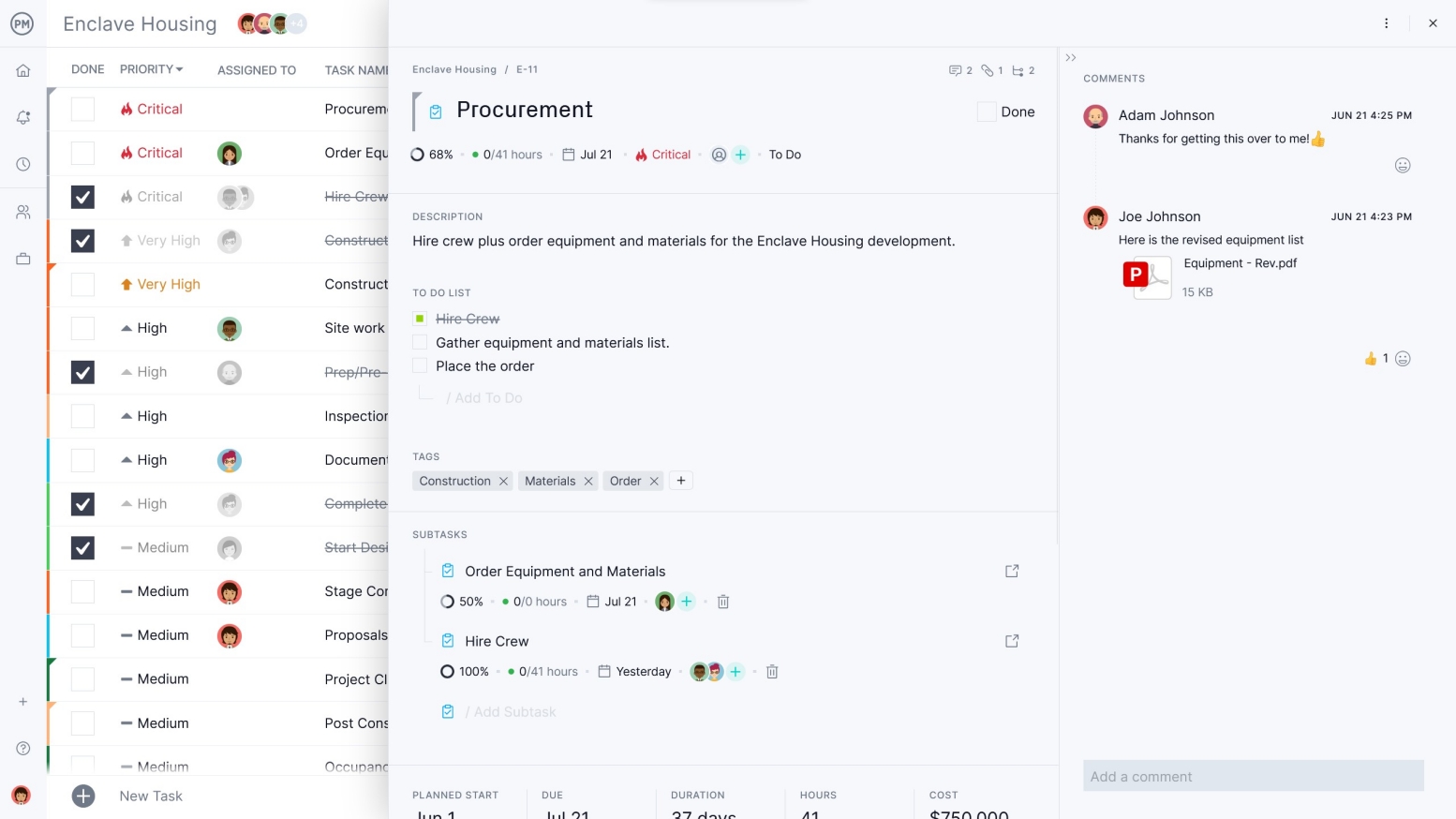
Enhance Tracking and Reporting
Our tracking is robust, combining real-time project and portfolio dashboards, customizable reports and secure timesheets. Dashboards offer an immediate view of progress, costs, risks and resource utilization, while reports can be tailored to highlight specific KPIs for internal teams or external stakeholders.
Timesheets are integrated and secure, capturing hours worked for accurate billing and payroll and feeding directly into performance metrics. This comprehensive tracking ensures managers can make informed decisions, mitigate risks proactively and maintain accountability across the entire project lifecycle.
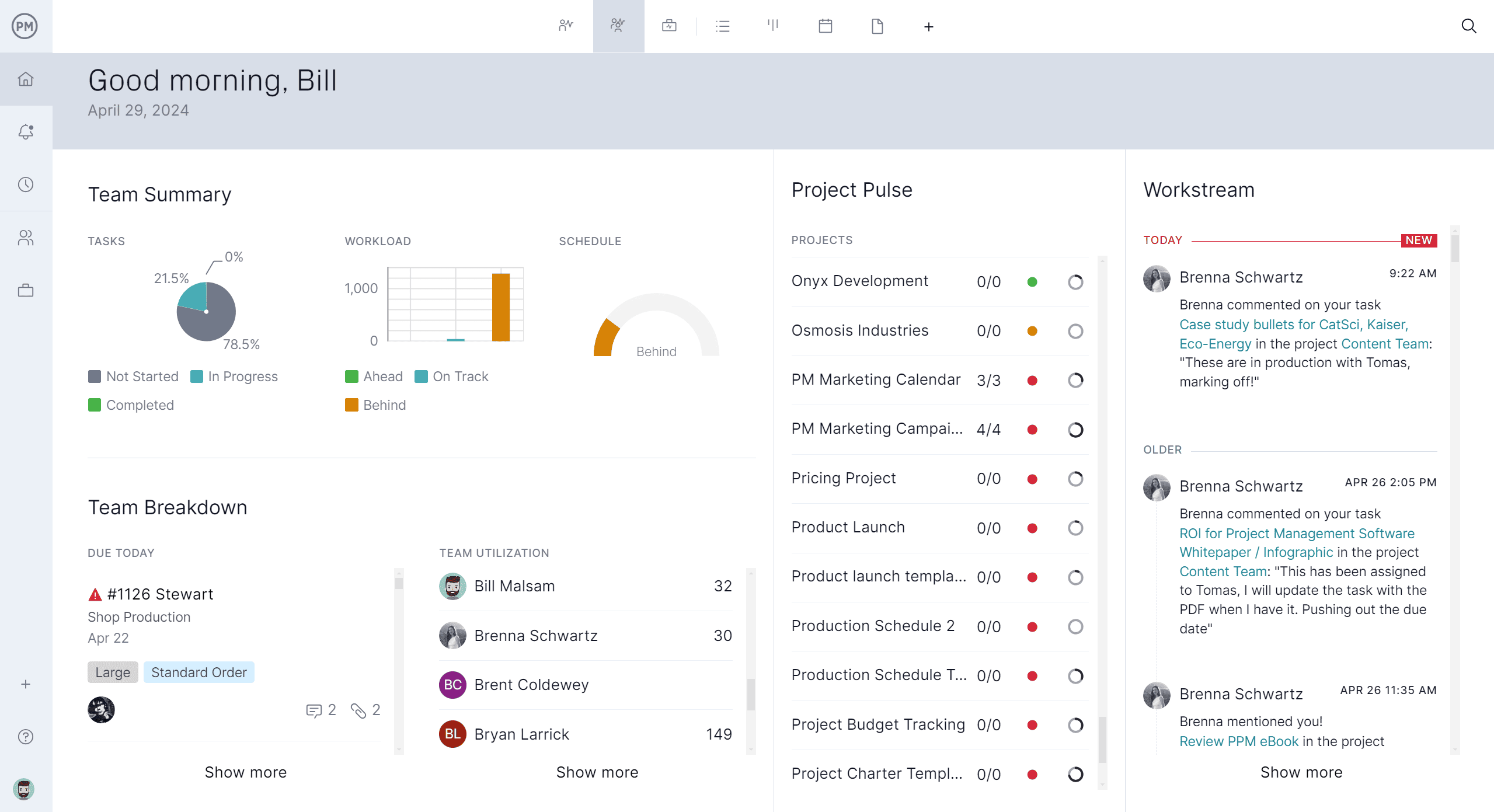
Related Proposal Content
There is more to understanding proposal management than proposal examples, as helpful as they might be. For readers who care to learn more about this process, check out the links below. They lead to more free templates, how to write proposals and a lot more.
- 12 Free Proposal Templates for Submitting Proposals
- RFP Template (Request for Proposal) – Free Word Download
- How to Write a Work Proposal (with Example & Template)
- How to Write a Project Proposal (Examples & Template Included)
- How to Write a Service Proposal: Sample & Template
- How to Write a Bid Proposal (Templates Included)
ProjectManager is online project and portfolio management software that connects teams, whether they’re in the office or out in the field. They can share files, comment at the task level and stay updated with email and in-app notifications. Join teams at Avis, Nestle and Siemens who are using our software to deliver successful projects. Get started with ProjectManager today for free.

